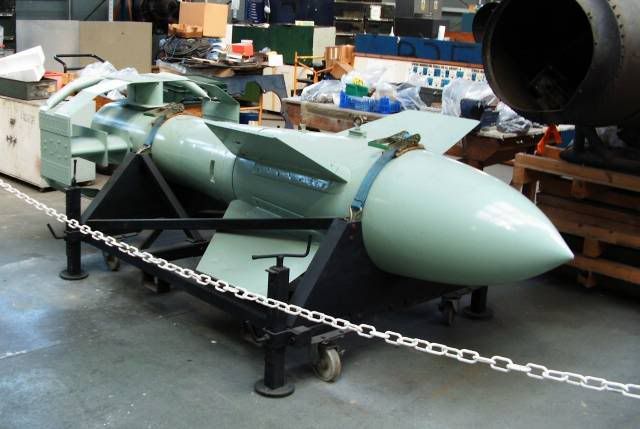What is it?
Join Date: Aug 2000
Location: London, England
Posts: 271
Likes: 0
Received 0 Likes
on
0 Posts
It's a Ruhrstahl SD1400 X "Fritz-X" radio-guided rocket bomb used against Allied shipping targets in the Mediterranean. It was quickly found that the guidance system could be jammed, but a number of ships were hit and sunk.
Join Date: Jan 2003
Location: Manchester
Posts: 323
Likes: 0
Received 0 Likes
on
0 Posts
Hi G It's a German bomb called Fritz X Don't know much more than that though, bombs aint my thing. Why I remember it's name is a mystery!!
Rgds Dr I
Edit: You are fast fast Rallye Driver!

Rgds Dr I
Edit: You are fast fast Rallye Driver!
Spoon PPRuNerist & Mad Inistrator
IIRC, these feature on the Airfix model of the He177, the 4-engine, 2-propellor bomber. Nice model, crap aircraft!
SD
SD
No - I think you're wrong. He said whilst trying to remember modelling the He177 25 odd years ago. The missile on the Airfix model had a rocket motor underneath the main body....

Hs. 293
There is some info here:
http://www.walter-rockets.i12.com/missiles/hs293b.htm

Hs. 293
There is some info here:
http://www.walter-rockets.i12.com/missiles/hs293b.htm
Join Date: Mar 2001
Location: Asgard
Posts: 488
Likes: 0
Received 0 Likes
on
0 Posts
Found it!
When I was a spotty yoof, I was given for Christmas the 1966 Aircraft Annual (Ian Allen)
In it there is an article called "The First Generation" by Alfred Price A.R.Ae.S which details the development and use of three weapons; the X1, the Hs293 glider bomb and the X4 which was a wire guided air to air missile. The deployment of the X1 seems very risky, because of the requirement of the bomber to slow down on release to around 120 mph in order for it to arrive directly over the target at the time of impact. The bomb aimer would just need to keep the weapons` tracking flare superimposed on the target.
As soon as the Salerno bridgehead had been established complete with forward airstrips, spitfires arrived on the scene and the naval forces received the necessary air support, and German bombers could not maintain the steady and slow flight path required to make successful attacks.
"From September 9th to 19th 1943 the missile sank some 68000 tons of shipping and damaged a futher 90000 tons. For the remainder of the war, however, the X1 did not achieve a single success"
When I was a spotty yoof, I was given for Christmas the 1966 Aircraft Annual (Ian Allen)
In it there is an article called "The First Generation" by Alfred Price A.R.Ae.S which details the development and use of three weapons; the X1, the Hs293 glider bomb and the X4 which was a wire guided air to air missile. The deployment of the X1 seems very risky, because of the requirement of the bomber to slow down on release to around 120 mph in order for it to arrive directly over the target at the time of impact. The bomb aimer would just need to keep the weapons` tracking flare superimposed on the target.
As soon as the Salerno bridgehead had been established complete with forward airstrips, spitfires arrived on the scene and the naval forces received the necessary air support, and German bombers could not maintain the steady and slow flight path required to make successful attacks.
"From September 9th to 19th 1943 the missile sank some 68000 tons of shipping and damaged a futher 90000 tons. For the remainder of the war, however, the X1 did not achieve a single success"








